Design and Realization of an UHF Frequency Reconfigurable Antenna for Hybrid Connectivity LPWAN and LEO Satellite Networks
Abstract
:1. Introduction
1.1. LoRaWAN
1.2. LEO Satellites for IoT
1.3. Power Consumption
1.4. Literature Review
2. Antenna Design
2.1. Design Methodology
2.2. Antenna Parametric Study
2.2.1. Parametric Study on Loaded Lumped Components
2.2.2. Parametric Study on the PIN Diode Equivalent Model
2.3. Matching Network
3. Antenna Prototype and Measurements
4. Results Analysis
5. Conclusions
Author Contributions
Funding
Institutional Review Board Statement
Informed Consent Statement
Data Availability Statement
Conflicts of Interest
References
- Rehman, A.-U.; Abbasi, A.Z.; Islam, N.; Shaikh, Z.A. A review of wireless sensors and networks’ applications in agriculture. Comput. Stand. Interfaces 2014, 36, 263–270. [Google Scholar] [CrossRef]
- Palattella, M.R.; Accettura, N. Enabling Internet of Everything Everywhere: LPWAN with Satellite Backhaul. In Proceedings of the 2018 Global Information Infrastructure and Networking Symposium (GIIS), Thessaloniki, Greece, 23–25 October 2018; pp. 1–5. [Google Scholar]
- Mekki, K.; Bajic, E.; Chaxel, F.; Meyer, F. Overview of Cellular LPWAN Technologies for IoT Deployment: Sigfox, LoRaWAN, and NB-IoT. In Proceedings of the 2018 IEEE International Conference on Pervasive Computing and Communications Workshops (PerCom Workshops), Athens, Greece, 19–23 March 2018; pp. 197–202. [Google Scholar]
- Osorio, A.; Calle, M.; Soto, J.D.; Candelo-Becerra, J.E. Routing in LoRaWAN: Overview and Challenges. IEEE Commun. Mag. 2020, 58, 72–76. [Google Scholar] [CrossRef]
- Qu, Z.; Zhang, G.; Cao, H.; Xie, J. LEO Satellite Constellation for Internet of Things. IEEE Access 2017, 5, 18391–18401. [Google Scholar] [CrossRef]
- Kineis Website. Available online: https://www.kineis.com/ (accessed on 12 August 2021).
- Lacuna Space Website. Available online: https://lacuna.space/ (accessed on 12 August 2021).
- ARTIC Chipset: Technical Specifications. Available online: https://www.cls-telemetry.com/argos-solutions/argos-products/modems/artic-chipset/#technical-specifications (accessed on 12 August 2021).
- AGROS System. Available online: https://www.cls-telemetry.com/argos-solutions/the-argos-system/ (accessed on 12 August 2021).
- Webinar: Kineis Reveal New Space IoT Use Cases. Available online: https://www.kineis.com/wp-content/uploads/2020/12/201210-Webinar-Kineis-Reveal-new-space-IoT-use-cases.pdf (accessed on 12 August 2021).
- Themalil, M.; Majed, M.; Rammal, M.; Martinod, E.; Jecko, B. Miniaturized Pixel Antenna for Implantation on the ARGOS CubeSat 4U. In Proceedings of the 2019 IEEE-APS Topical Conference on Antennas and Propagation in Wireless Communications (APWC), Granada, Spain, 9–13 September 2019; pp. 154–156. [Google Scholar] [CrossRef]
- Fragnier, R.; Feat, L.; Contreres, R.; Palacin, B.; Elis, K.; Bellion, A.; Le Fur, G. Collocated Compact UHF and L-Band Antenna for Nanosatellite ARGOS Program. In Proceedings of the 2019 13th European Conference on Antennas and Propagation (EuCAP), Krakow, Poland, 31 March–5 April 2019; pp. 1–4. [Google Scholar]
- Lacuna Space Constellation. Available online: https://www.newspace.im/constellations/lacuna-space (accessed on 12 August 2021).
- LoRaWAN Connectivity Everywhere, from Space-Thomas Telkamp (Lacuna Space). Available online: https://www.youtube.com/watch?v=5Pofqck4gd0 (accessed on 12 August 2021).
- Trinh, L.H.; Truong, N.V.; Ferrero, F. Low Cost Circularly Polarized Antenna for IoT Space Applications. Electronics 2020, 9, 1564. [Google Scholar] [CrossRef]
- Circularly Polarized Antenna for LoRaWAN from Space-Fabien Ferrero (Université Côte d’Azur). Available online: https://www.youtube.com/watch?v=4PZ3J9rk0_4 (accessed on 12 August 2021).
- Available online: https://www.qorvo.com/products/p/RFPA0133 (accessed on 12 August 2021).
- Murata, CMWX1ZZABZ-78 Sub-G Module Data Sheet. Available online: https://wireless.murata.com/pub/RFM/data/type_abz.pdf (accessed on 12 August 2021).
- STM32 Ultra Low Power MCUs. Available online: https://www.st.com/en/microcontrollers-microprocessors/stm32-ultra-low-power-mcus.html (accessed on 12 August 2021).
- Semtech SX1276, LoRa Core™ 137MHz to 1020MHz Long Range Low Power Transceiver. Available online: https://www.semtech.com/products/wireless-rf/lora-transceivers/sx1276#download-resources (accessed on 12 August 2021).
- Lysogor, I.; Voskov, L.; Rolich, A.; Efremov, S. Study of Data Transfer in a Heterogeneous LoRa-Satellite Network for the Internet of Remote Things. Sensors 2019, 19, 3384. [Google Scholar] [CrossRef] [PubMed] [Green Version]
- Available online: https://www.johansontechnology.com/chip-antenna-selection (accessed on 12 August 2021).
- Bouyedda, A.; Barelaud, B.; Gineste, L. Investigation on PIFA and Folded-IFA for TPMS Receiver. In Proceedings of the 2021 96th ARFTG Microwave Measurement Conference (ARFTG), San Diego, CA, USA, 18–22 January 2021; pp. 1–4. [Google Scholar]
- Iqbal, A.; Smida, A.; Mallat, N.K.; Ghayoula, R.; Elfergani, I.; Rodriguez, J.; Kim, S. Frequency and Pattern Reconfigurable Antenna for Emerging Wireless Communication Systems. Electronics 2019, 8, 407. [Google Scholar] [CrossRef] [Green Version]
- Yeom, I.; Choi, J.; Kwoun, S.-S.; Lee, B.; Jung, C.W. Analysis of RF Front-End Performance of Reconfigurable Antennas with RF Switches in the Far Field. Int. J. Antennas Propag. 2014, 2014, 1–14. [Google Scholar] [CrossRef]
- Floch, J.M.; Singh, A.; Desclos, L. Set of new compact antennas suitable for integration on PCB. In Proceedings of the 2014 Loughborough Antennas and Propagation Conference (LAPC), Loughborough, UK, 10–11 November 2014; pp. 40–43. [Google Scholar]
- Kumar, S.; Buckley, J.L.; Barton, J.; Pigeon, M.; Newberry, R.; Rodencal, M.; Hajzeraj, A.; Hannon, T.; Rogers, K.; Casey, D.; et al. A Wristwatch-Based Wireless Sensor Platform for IoT Health Monitoring Applications. Sensors 2020, 20, 1675. [Google Scholar] [CrossRef] [PubMed] [Green Version]
- Bouyedda, A.; Barelaud, B.; Gineste, L. Design and Realization of a Compact Size Active Antenna for UHF Satellite Communication. In Proceedings of the 2021 97th ARFTG Microwave Measurement Conference (ARFTG), Atlanta, GA, USA, 11 June 2021; pp. 1–4. [Google Scholar]
- Di Serio, A.; Buckley, J.; Barton, J.; Newberry, R.; Rodencal, M.; Dunlop, G.; O’Flynn, B. Potential of Sub-GHz Wireless for Future IoT Wearables and Design of Compact 915 MHz Antenna. Sensors 2017, 18, 22. [Google Scholar] [CrossRef] [PubMed] [Green Version]
- Selek, A.; Turkmen, C.; Secmen, M. Compact planar folded monopole antenna with coupling mechanism for Quad ISM band, GNSS and UMTS applications. In Proceedings of the 2018 11th German Microwave Conference (GeMiC), Freiburg, Germany, 12–14 March 2018; pp. 211–214. [Google Scholar]
- Loizou, L.; Buckley, J.; O’Flynn, B. Design and Analysis of a Dual-Band Inverted-F Antenna with Orthogonal Frequency-Controlled Radiation Planes. IEEE Trans. Antennas Propag. 2013, 61, 3946–3951. [Google Scholar] [CrossRef]
- He, S.; Xie, J. A Novel Compact Printed Antenna Used in TPMS or Other Complex and Variable Environments. IEEE Trans. Antennas Propag. 2008, 56, 24–30. [Google Scholar] [CrossRef]
- Ferrero, F.; Toure, M.B. Dual-band LoRa Antenna: Design and Experiments. In Proceedings of the 2019 IEEE Conference on Antenna Measurements & Applications (CAMA), Kuta, Indonesia, 23–25 October 2019; pp. 243–246. [Google Scholar]
- Materials Property Data. 2021. Available online: http://www.matweb.com/ (accessed on 12 August 2021).
- Behzadnezhad, B.; Collick, B.D.; Behdad, N.; McMillan, A.B. Dielectric properties of 3D-printed materials for anatomy specific 3D-printed MRI coils. J. Magn. Reson. 2018, 289, 113–121. [Google Scholar] [CrossRef] [PubMed]
- Wang, C.-J.; Hsieh, D.-H. Bandwidth Enhancement Technique of the Meandered Monopole Antenna. Int. J. Antennas Propag. 2015, 2015, 1–6. [Google Scholar] [CrossRef] [Green Version]


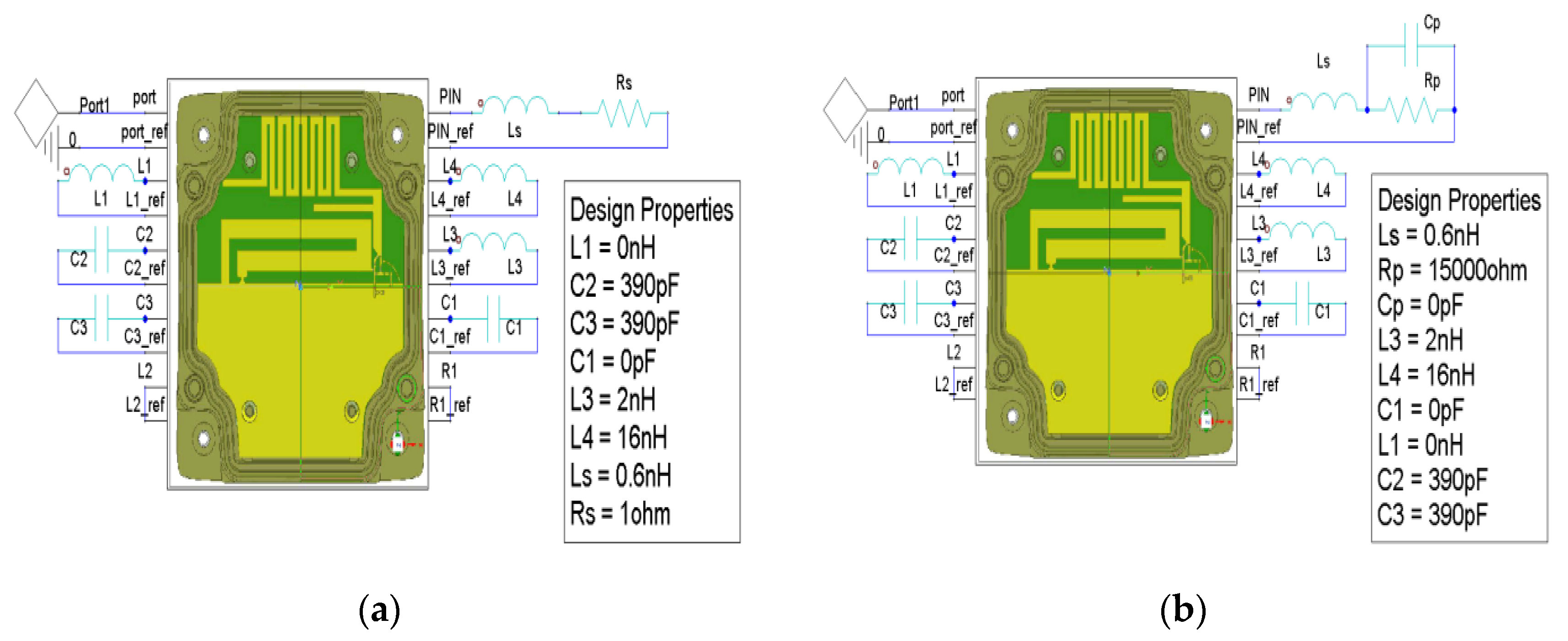
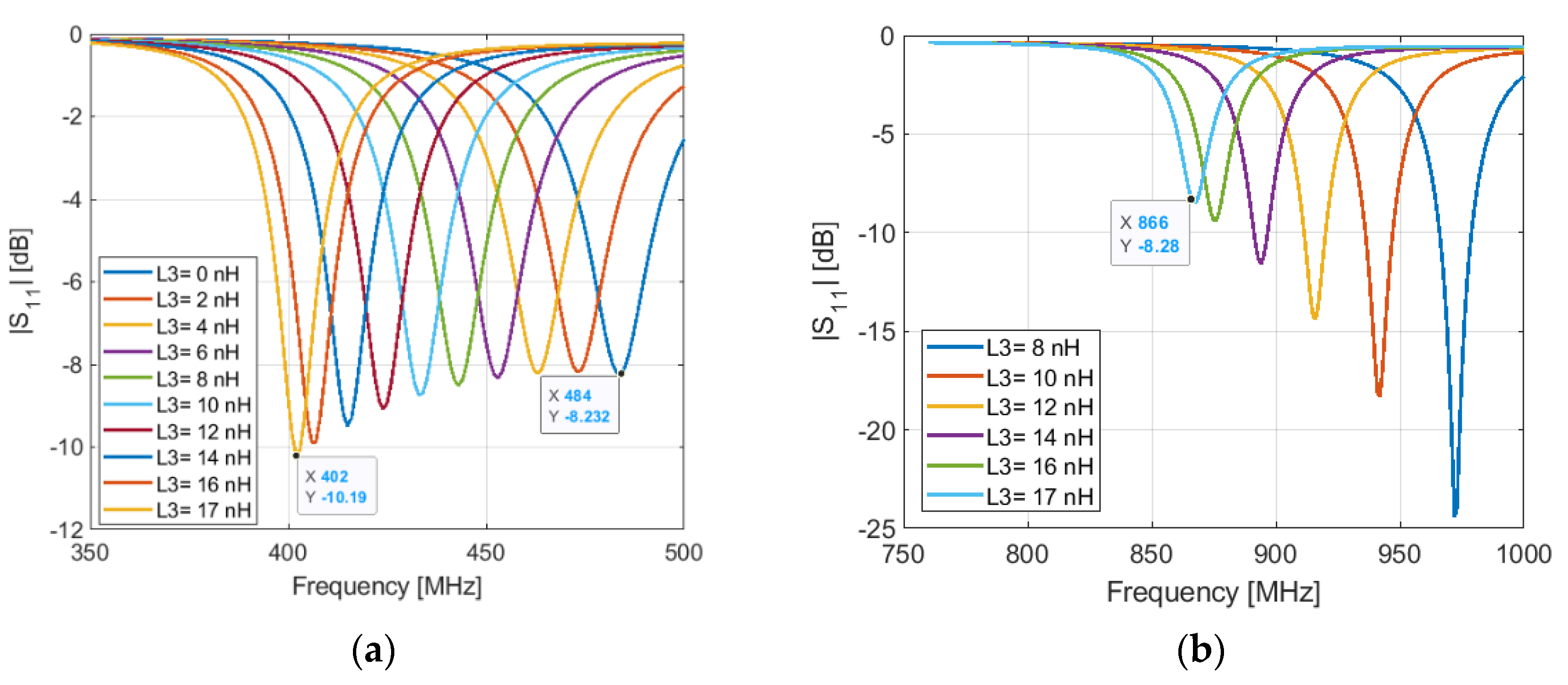
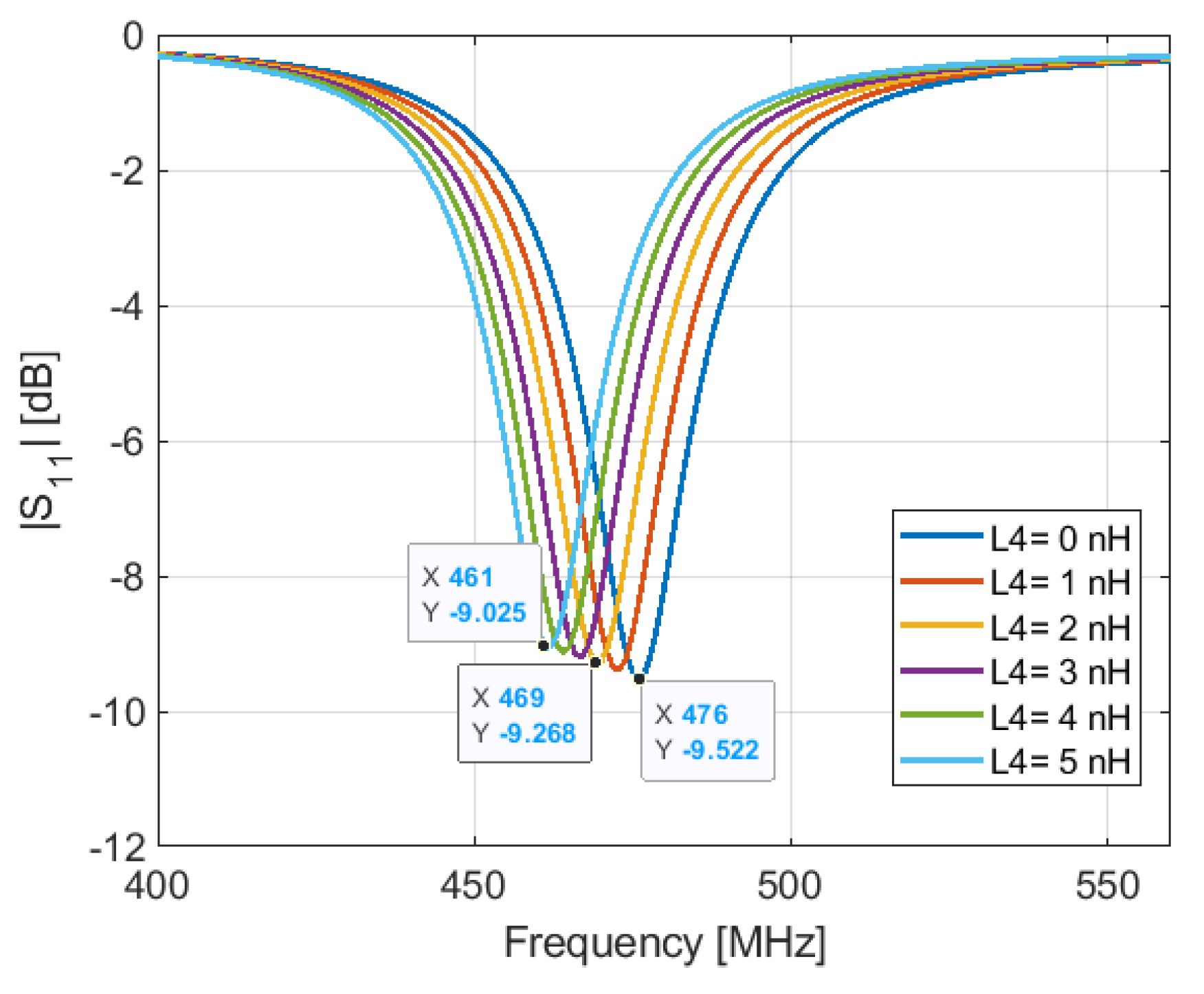

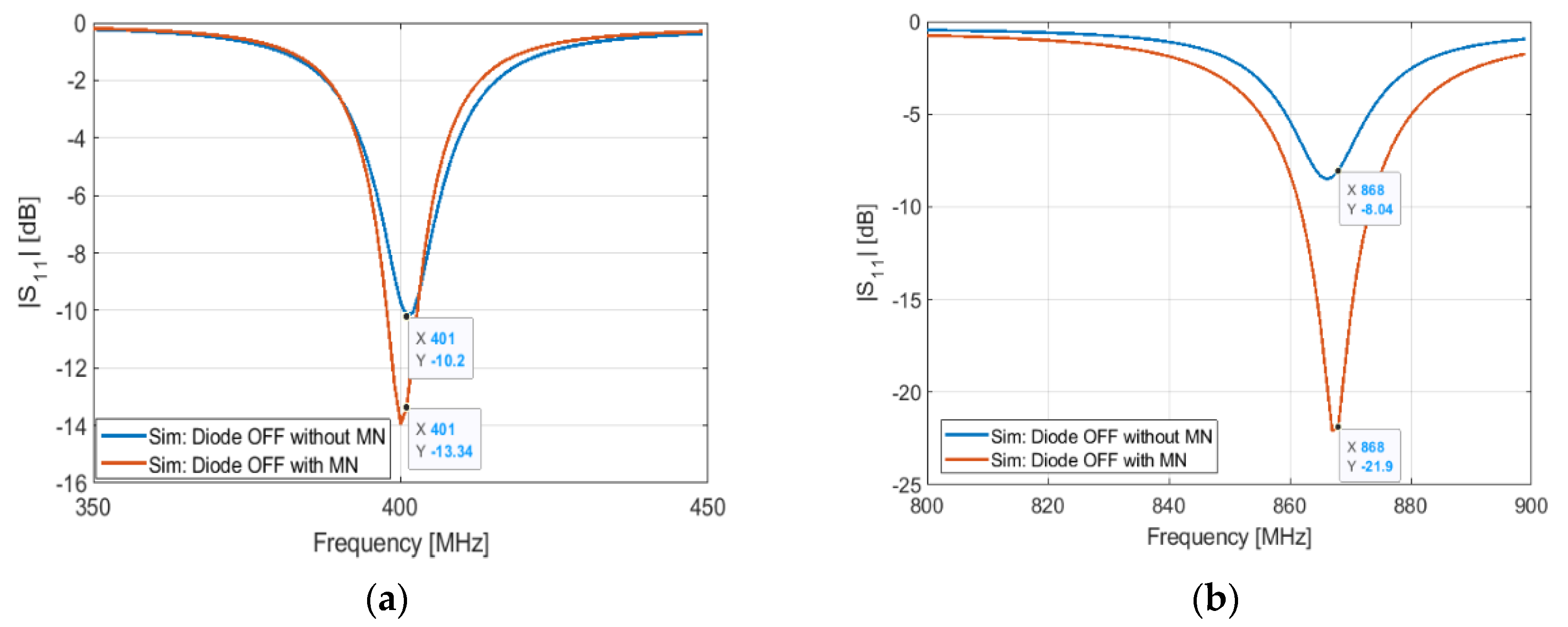
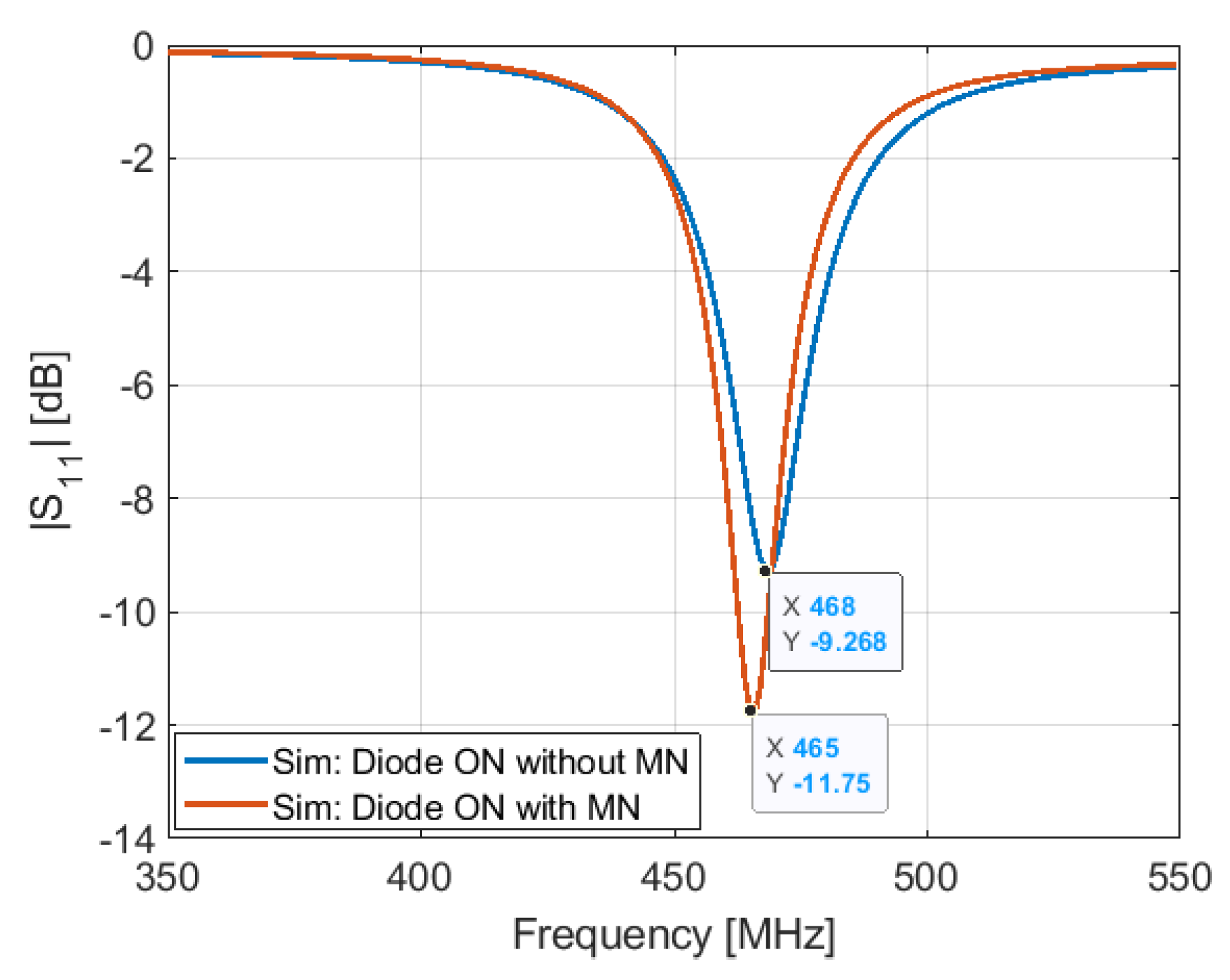
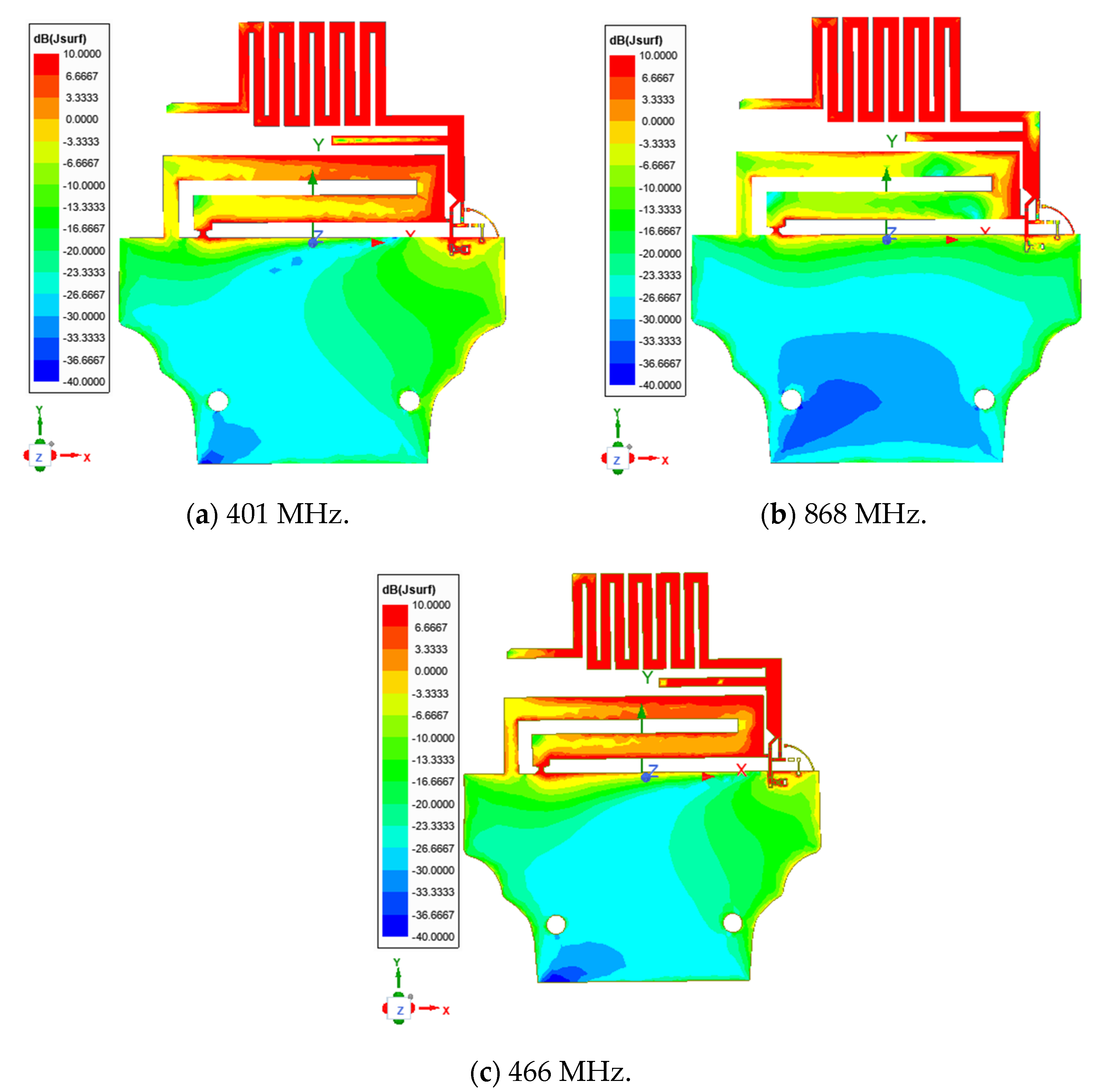
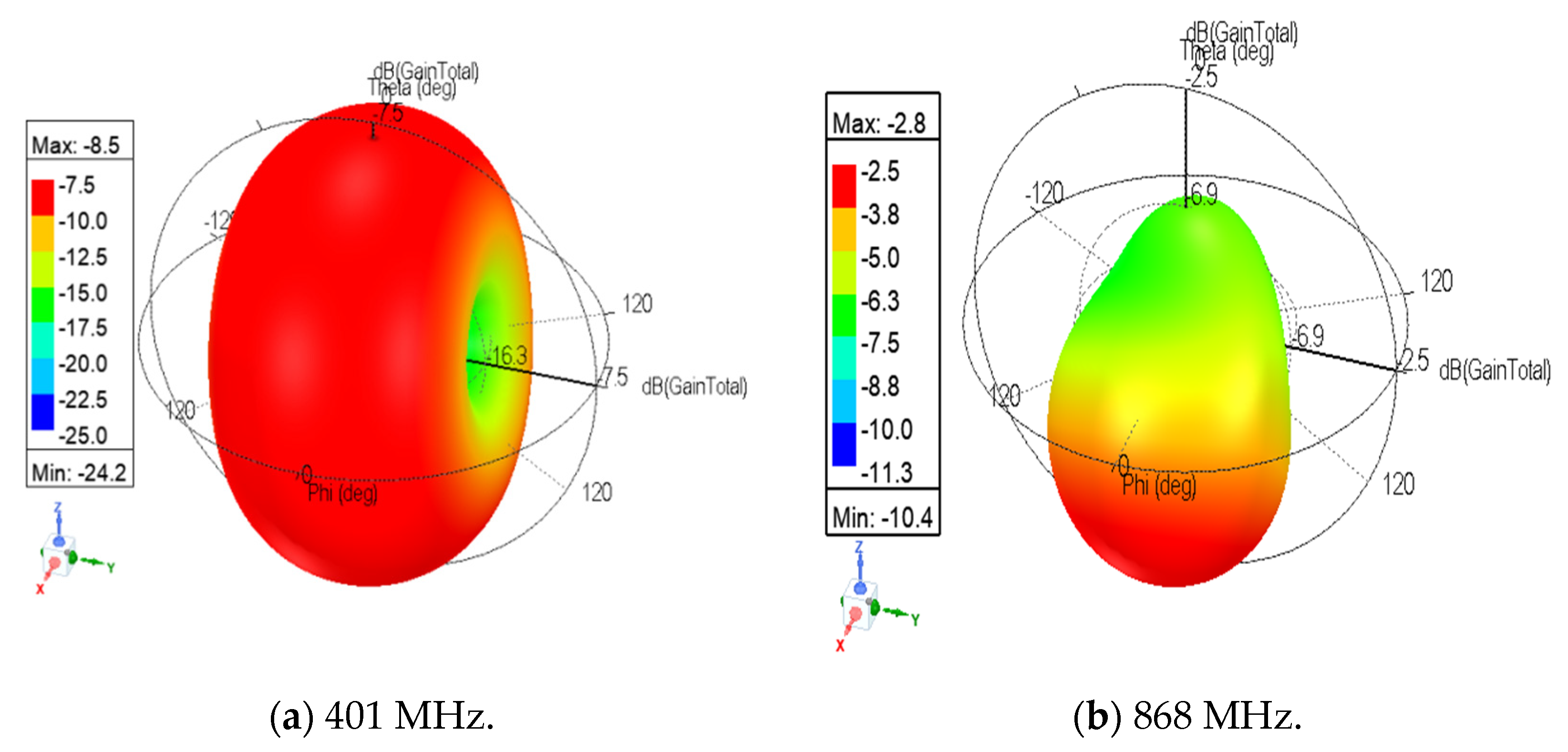



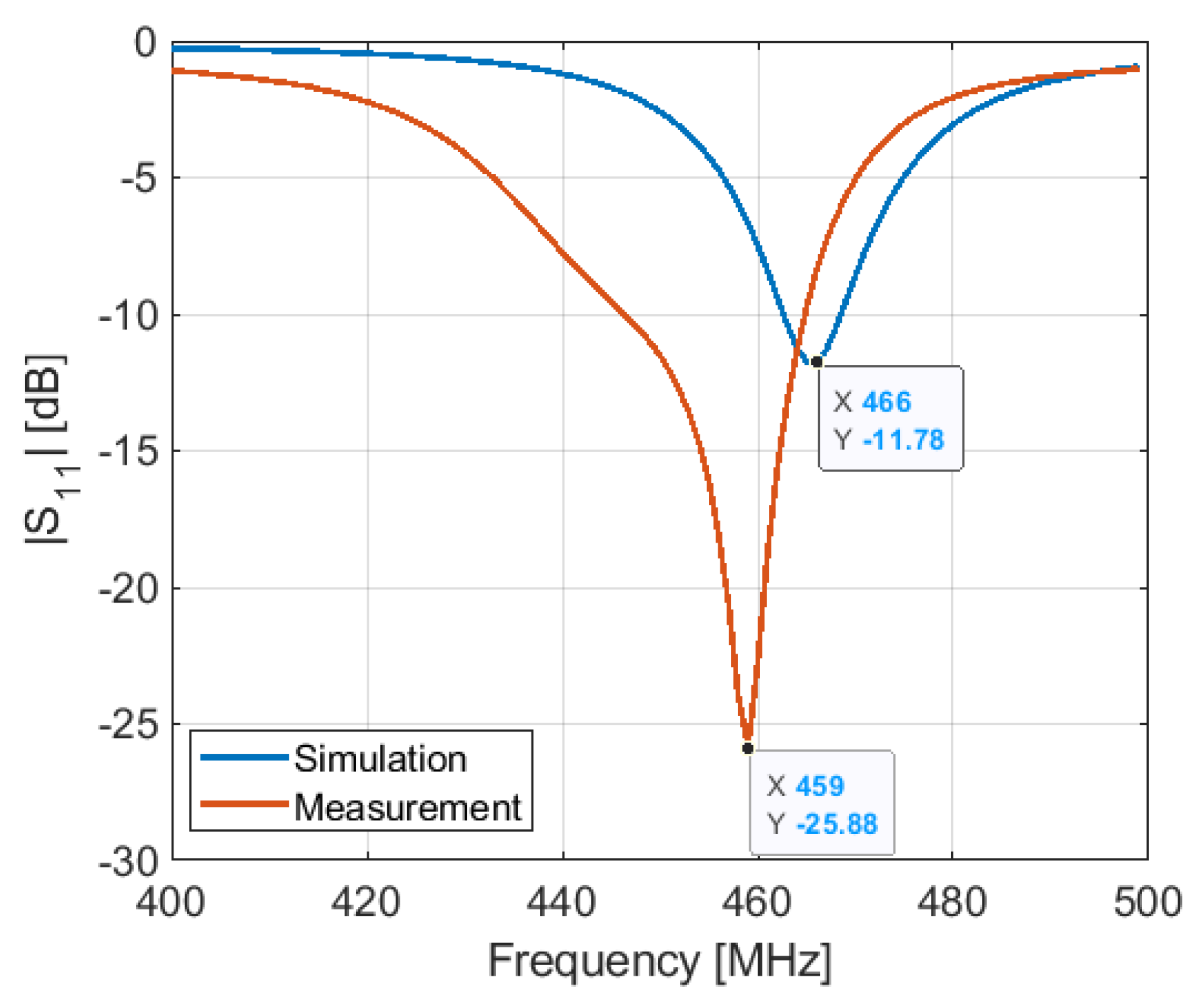

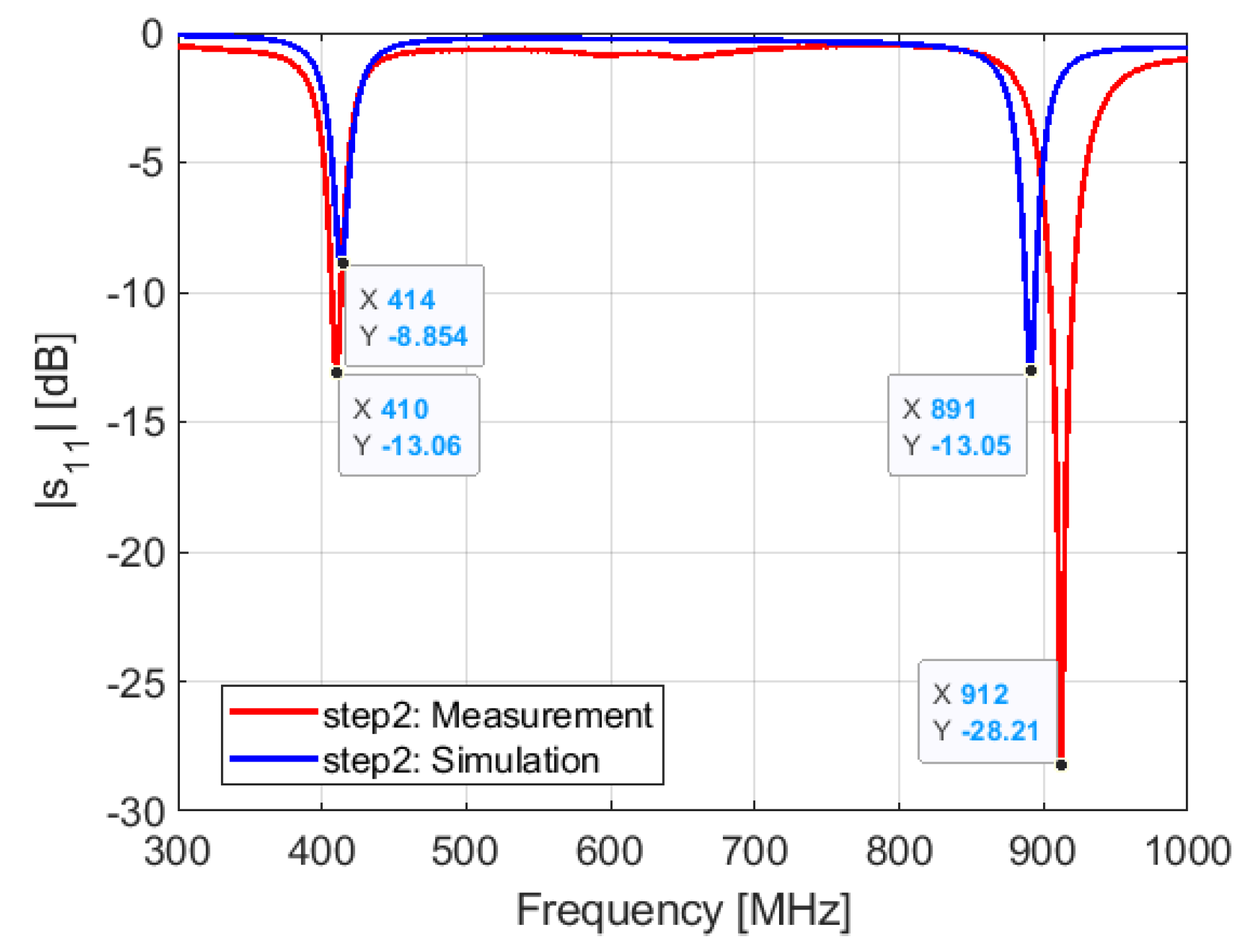
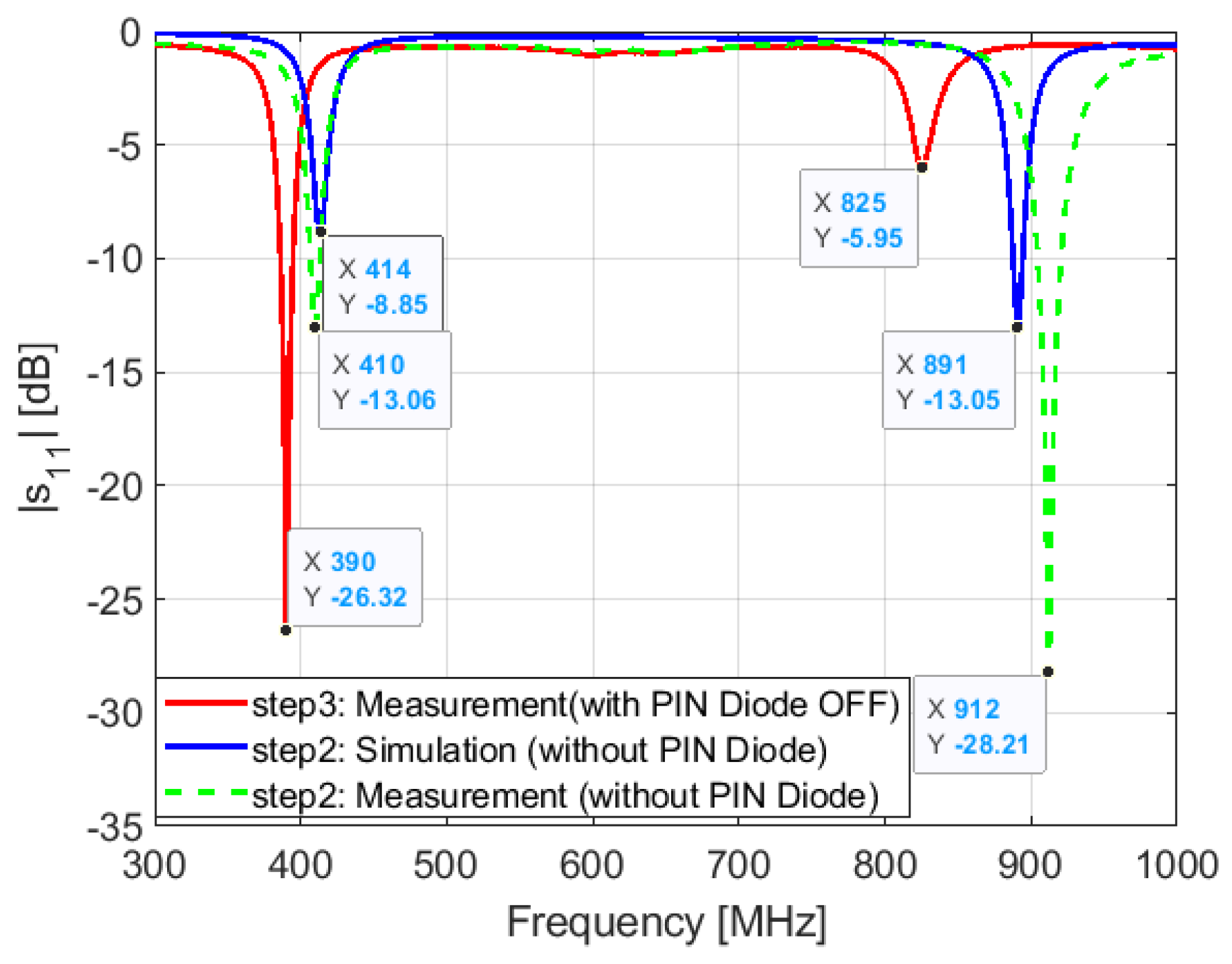
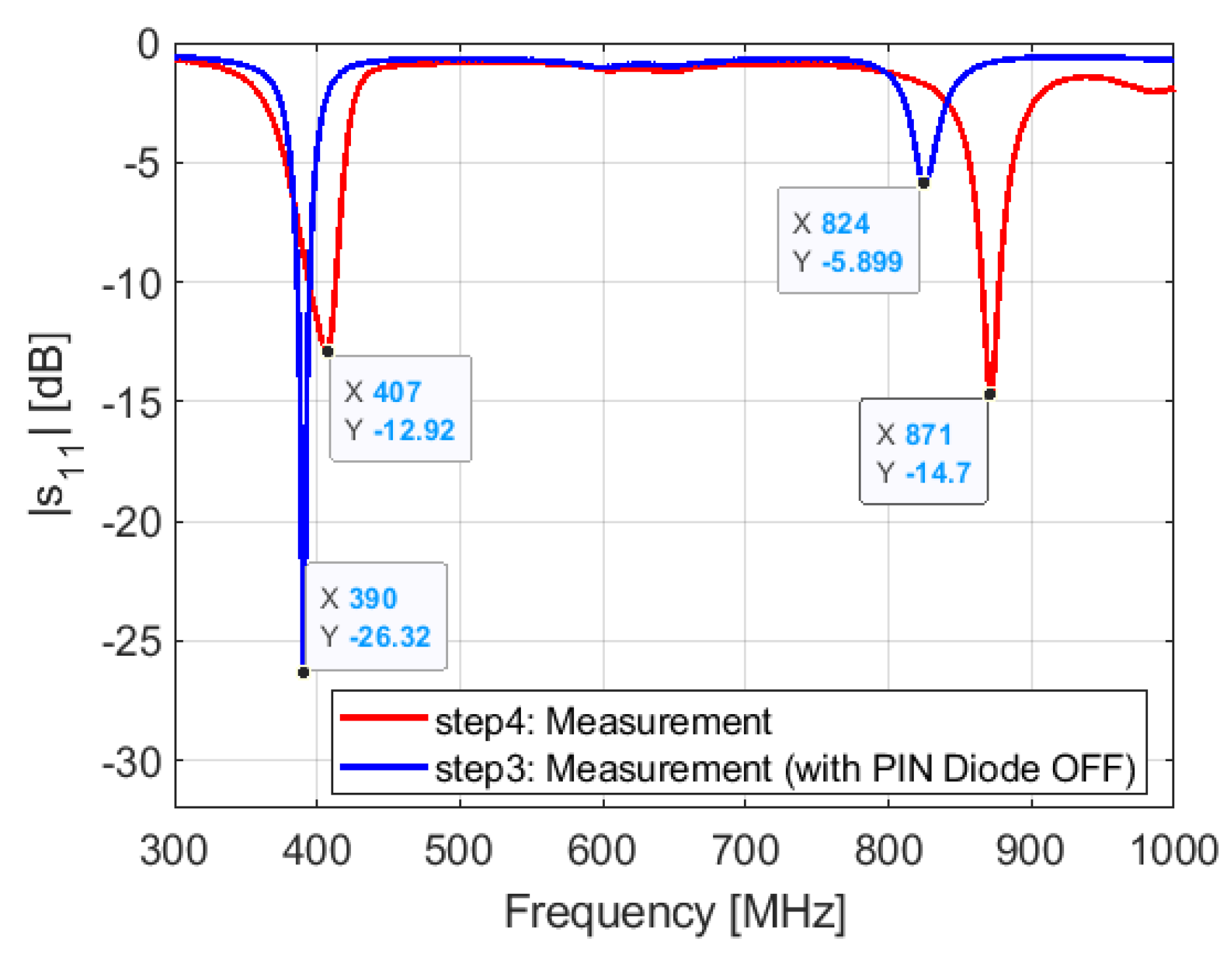
| Parameter | Value (mm) | Parameter | Value (mm) |
|---|---|---|---|
| L | 88 | l2 | 23 |
| W | 78 | l3 | 18.55 |
| C | 8 | l4 | 16.3 |
| c1 | 8.6 | l5 | 4.4 |
| G | 2 | l6 | 47.3 |
| g1 | 0.65 | W | 2 |
| g2 | 3 | w1 | 1.85 |
| L | 12.5 | w2 | 3.3 |
| l1 | 14.3 | w3 | 0.61 |
Publisher’s Note: MDPI stays neutral with regard to jurisdictional claims in published maps and institutional affiliations. |
© 2021 by the authors. Licensee MDPI, Basel, Switzerland. This article is an open access article distributed under the terms and conditions of the Creative Commons Attribution (CC BY) license (https://creativecommons.org/licenses/by/4.0/).
Share and Cite
Bouyedda, A.; Barelaud, B.; Gineste, L. Design and Realization of an UHF Frequency Reconfigurable Antenna for Hybrid Connectivity LPWAN and LEO Satellite Networks. Sensors 2021, 21, 5466. https://doi.org/10.3390/s21165466
Bouyedda A, Barelaud B, Gineste L. Design and Realization of an UHF Frequency Reconfigurable Antenna for Hybrid Connectivity LPWAN and LEO Satellite Networks. Sensors. 2021; 21(16):5466. https://doi.org/10.3390/s21165466
Chicago/Turabian StyleBouyedda, Abdellatif, Bruno Barelaud, and Laurent Gineste. 2021. "Design and Realization of an UHF Frequency Reconfigurable Antenna for Hybrid Connectivity LPWAN and LEO Satellite Networks" Sensors 21, no. 16: 5466. https://doi.org/10.3390/s21165466
APA StyleBouyedda, A., Barelaud, B., & Gineste, L. (2021). Design and Realization of an UHF Frequency Reconfigurable Antenna for Hybrid Connectivity LPWAN and LEO Satellite Networks. Sensors, 21(16), 5466. https://doi.org/10.3390/s21165466






